From the Trenches
Treason, Plot, and Witchcraft
By SAMIR S. PATEL
Monday, February 09, 2015
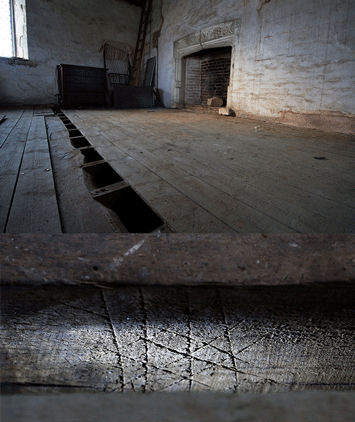 Remember, remember, the fifth of November.” In one of the United Kingdom’s largest and most historic homes, archaeologists have found a lingering memory of the paranoia and angst that followed the Gunpowder Plot of 1605, when Robert Catesby and a group of Catholic conspirators (including Guy Fawkes) attempted to blow up both houses of Parliament and kill the Protestant King James I.
Remember, remember, the fifth of November.” In one of the United Kingdom’s largest and most historic homes, archaeologists have found a lingering memory of the paranoia and angst that followed the Gunpowder Plot of 1605, when Robert Catesby and a group of Catholic conspirators (including Guy Fawkes) attempted to blow up both houses of Parliament and kill the Protestant King James I.
Six-hundred-year-old Knole House in Kent was then owned by Thomas Sackville, Lord Treasurer. Sackville was having the home renovated to host the king himself, work that included creating the “Upper King’s Room,” where the monarch would have stayed (but never actually did). As part of a five-year project of study and conservation, researchers recently pulled up floorboards in the room and found what are known as apotropaic marks—also called “witchmarks” or “demon traps.” These crosshatch patterns had been carved into beams around the fireplace and under the floor by the craftsmen working on the room, as protection for the royal occupant from witchcraft and demonic possession. Tree-ring dating of the beams reveals that the marks were made just months after the Gunpowder Plot had been foiled.
In the hysteria that followed the plot, accusations of witchcraft and demonic activity were common, fueled in part by James’ demonization of Catholics and his interest in the supernatural. Two years earlier he passed a law imposing death for those engaging in witchcraft, and had once written a book, Daemonologie, supporting witch-hunting. According to James Wright of Museum of London Archaeology, which is working on the project, “These marks illustrate how fear governed the everyday lives of people living through the tumultuous years of the early seventeenth century.”
Shackled for Eternity
By JASON URBANUS
Monday, February 09, 2015
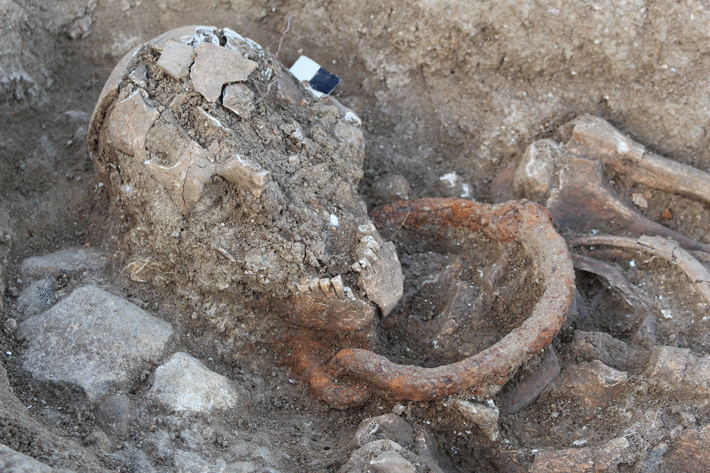
Archaeologists have recently uncovered a large Gallo-Roman necropolis in southwest France. Located just 800 feet from the Roman amphitheater in Saintes, the cemetery may have been the final resting place for many of the arena’s victims. Several hundred graves dating to the first and second centuries A.D. were found, including many double burials, in which two bodies were interred in one trench, lying head to foot. The archaeologists also excavated at least five individuals—four adults and one child—who were still wearing riveted iron shackles around their wrists, necks, or legs. The graves were almost entirely devoid of artifacts, except for that of a young child who was buried with coins on his or her eyes and seven small vases.
How to Eat a Shipwreck
By SAMIR S. PATEL
Monday, February 09, 2015
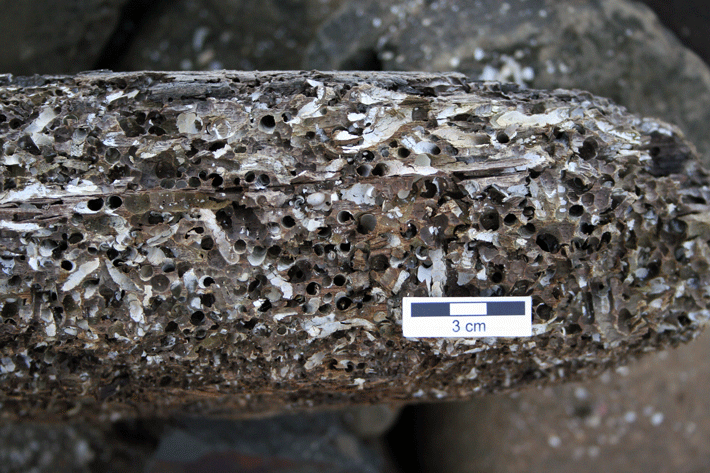 The family of mollusks known as shipworms are sometimes referred to as the “termites of the sea” because they bore through and eat submerged wood, including shipwrecks. Actual termites are able to digest wood because bacterial communities in their guts generate enzymes that break down wood fibers. But in a number of shipworm species, the cecum, or intestinal structure where they digest wood, doesn’t have a bacterial community to help out. Researchers have now found the missing microbes—living in specialized cells in shipworms’ gills. “I would say that this finding likely extends to many species,” says Dan Distel of the Northeastern University Marine Science Center. Useful enzymes then migrate to the cecum—scientists don’t know how just yet—where they break wood down into nutritious sugars, sugars that the shipworms then don’t have to share with a community of gut bacteria. This is the first time such an arrangement has been observed in the animal kingdom.
The family of mollusks known as shipworms are sometimes referred to as the “termites of the sea” because they bore through and eat submerged wood, including shipwrecks. Actual termites are able to digest wood because bacterial communities in their guts generate enzymes that break down wood fibers. But in a number of shipworm species, the cecum, or intestinal structure where they digest wood, doesn’t have a bacterial community to help out. Researchers have now found the missing microbes—living in specialized cells in shipworms’ gills. “I would say that this finding likely extends to many species,” says Dan Distel of the Northeastern University Marine Science Center. Useful enzymes then migrate to the cecum—scientists don’t know how just yet—where they break wood down into nutritious sugars, sugars that the shipworms then don’t have to share with a community of gut bacteria. This is the first time such an arrangement has been observed in the animal kingdom.
Tomb of the Jealous Dog
By JARRETT A. LOBELL
Monday, February 09, 2015
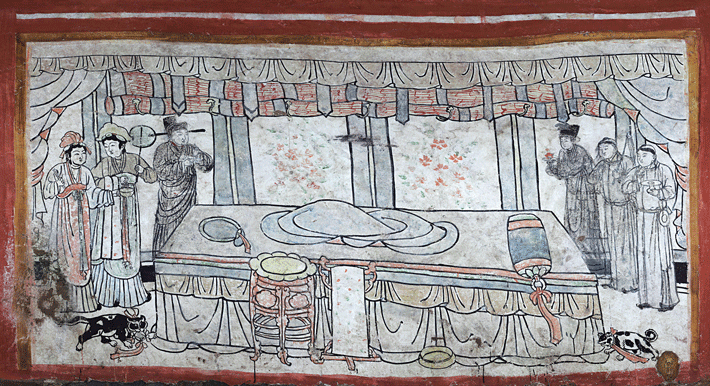
Archaeologists have uncovered a Liao Dynasty (A.D. 907–1125) brick tomb in Datong City in northern China’s Shanxi Province. The tomb had been looted, but only valuable, portable artifacts were taken, which left its remarkable wall paintings intact. The murals cover more than 160 square feet and depict constellations, wooden architecture, travel, and daily life. One panel shows servants standing around an empty bed while a cat plays with a silk ball and a dog, to the right, looks on, perhaps a bit jealously.
New Mosaics at Zeugma
By JARRETT A. LOBELL
Monday, February 09, 2015
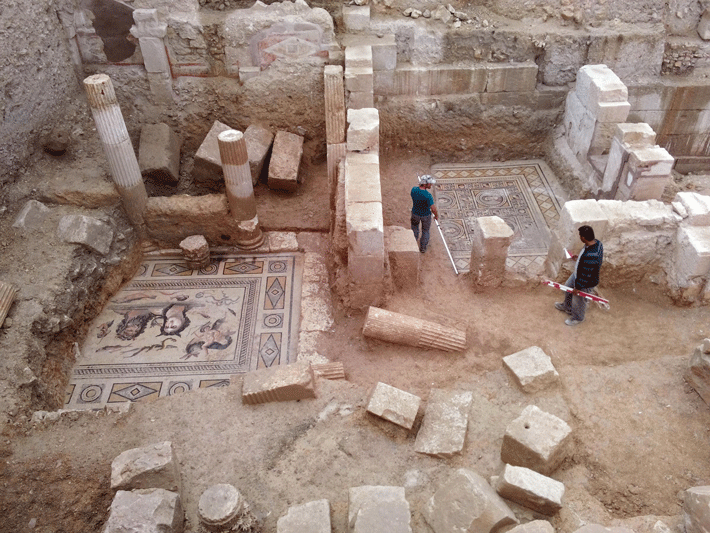
Continuing excavations in the House of the Muses at Zeugma in southeastern Turkey have uncovered even more spectacular Roman mosaics, as well as more of the house’s well-preserved architecture. In one of the newly discovered rooms, archaeologists uncovered a mosaic pavement depicting four young women framed by elaborate patterns. Although not identified by any inscriptions, the women may represent heroines from Greek mythology.
Advertisement
Advertisement
IN THIS ISSUE
From the Trenches
Seismic Shift
Off the Grid
Treasures of Rathfarnham Castle
History's Largest Megalith
Squaring the Circles
Hidden in a Coin Hoard
Autumn of the Master Builder
Buried With Care
New Mosaics at Zeugma
How to Eat a Shipwreck
Tomb of the Jealous Dog
Shackled for Eternity
Treason, Plot, and Witchcraft
Advertisement

Recent Issues
-
 May/June 2024
May/June 2024
-
 March/April 2024
March/April 2024
-
 January/February 2024
January/February 2024
-
 November/December 2023
November/December 2023
-
 September/October 2023
September/October 2023
-
 July/August 2023
July/August 2023
-
 May/June 2023
May/June 2023
-
 March/April 2023
March/April 2023
-
 January/February 2023
January/February 2023
-
 November/December 2022
November/December 2022
-
 September/October 2022
September/October 2022
-
 July/August 2022
July/August 2022
-
 May/June 2022
May/June 2022
-
 March/April 2022
March/April 2022
-
 January/February 2022
January/February 2022
-
 November/December 2021
November/December 2021
-
 September/October 2021
September/October 2021
-
 July/August 2021
July/August 2021
-
 May/June 2021
May/June 2021
-
 March/April 2021
March/April 2021
-
 January/February 2021
January/February 2021
-
 November/December 2020
November/December 2020
-
 September/October 2020
September/October 2020
-
 July/August 2020
July/August 2020
-
 May/June 2020
May/June 2020
-
 March/April 2020
March/April 2020
-
 January/February 2020
January/February 2020
-
 November/December 2019
November/December 2019
-
 September/October 2019
September/October 2019
-
 July/August 2019
July/August 2019
-
 May/June 2019
May/June 2019
-
 March/April 2019
March/April 2019
-
 January/February 2019
January/February 2019
-
 November/December 2018
November/December 2018
-
 September/October 2018
September/October 2018
-
 July/August 2018
July/August 2018
-
 May/June 2018
May/June 2018
-
 March/April 2018
March/April 2018
-
 January/February 2018
January/February 2018
-
 November/December 2017
November/December 2017
-
 September/October 2017
September/October 2017
-
 July/August 2017
July/August 2017
-
 May/June 2017
May/June 2017
-
 March/April 2017
March/April 2017
-
 January/February 2017
January/February 2017
-
 November/December 2016
November/December 2016
-
 September/October 2016
September/October 2016
-
 July/August 2016
July/August 2016
-
 May/June 2016
May/June 2016
-
 March/April 2016
March/April 2016
-
 January/February 2016
January/February 2016
-
 November/December 2015
November/December 2015
-
 September/October 2015
September/October 2015
-
 July/August 2015
July/August 2015
-
 May/June 2015
May/June 2015
-
 March/April 2015
March/April 2015
-
 January/February 2015
January/February 2015
-
 November/December 2014
November/December 2014
-
 September/October 2014
September/October 2014
-
 July/August 2014
July/August 2014
-
 May/June 2014
May/June 2014
-
 March/April 2014
March/April 2014
-
 January/February 2014
January/February 2014
-
 November/December 2013
November/December 2013
-
 September/October 2013
September/October 2013
-
 July/August 2013
July/August 2013
-
 May/June 2013
May/June 2013
-
 March/April 2013
March/April 2013
-
 January/February 2013
January/February 2013
-
 November/December 2012
November/December 2012
-
 September/October 2012
September/October 2012
-
 July/August 2012
July/August 2012
-
 May/June 2012
May/June 2012
-
 March/April 2012
March/April 2012
-
 January/February 2012
January/February 2012
-
 November/December 2011
November/December 2011
-
 September/October 2011
September/October 2011
-
 July/August 2011
July/August 2011
-
 May/June 2011
May/June 2011
-
 March/April 2011
March/April 2011
-
 January/February 2011
January/February 2011
Advertisement






